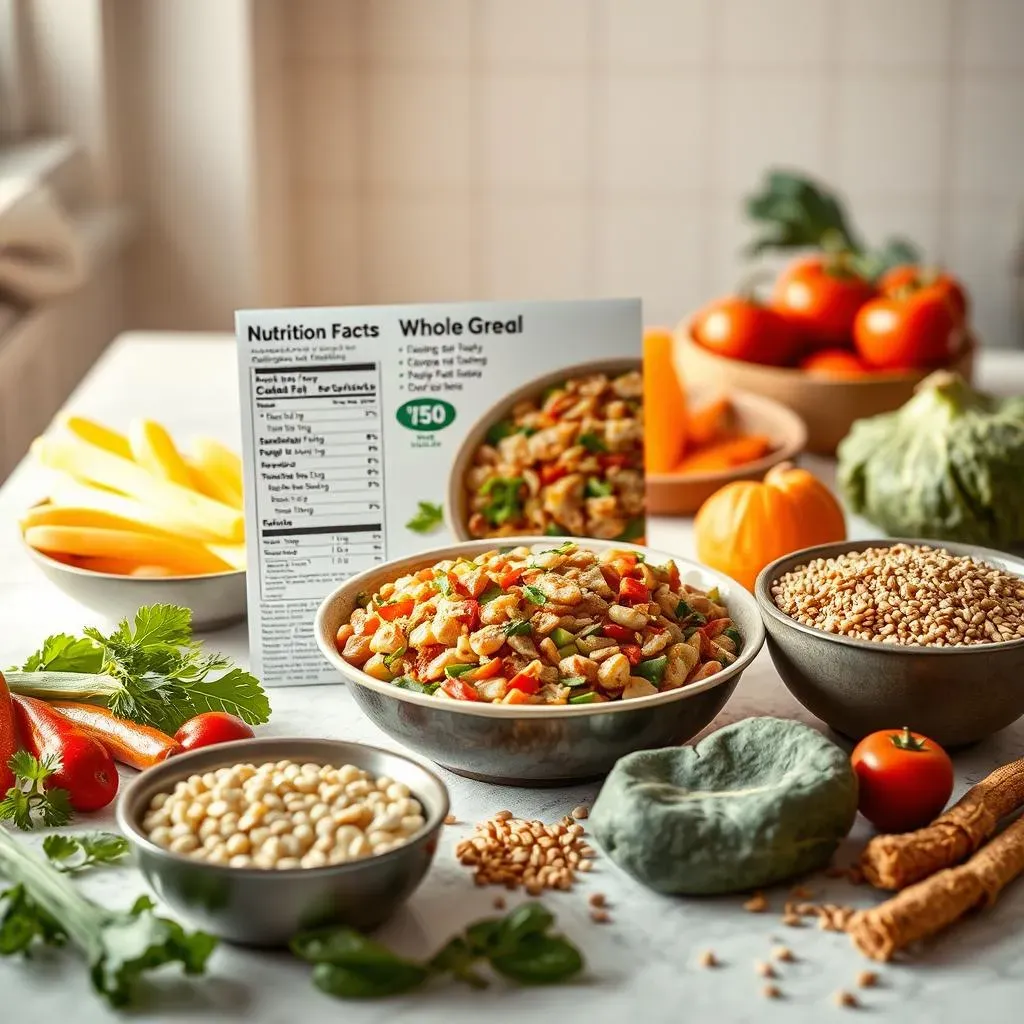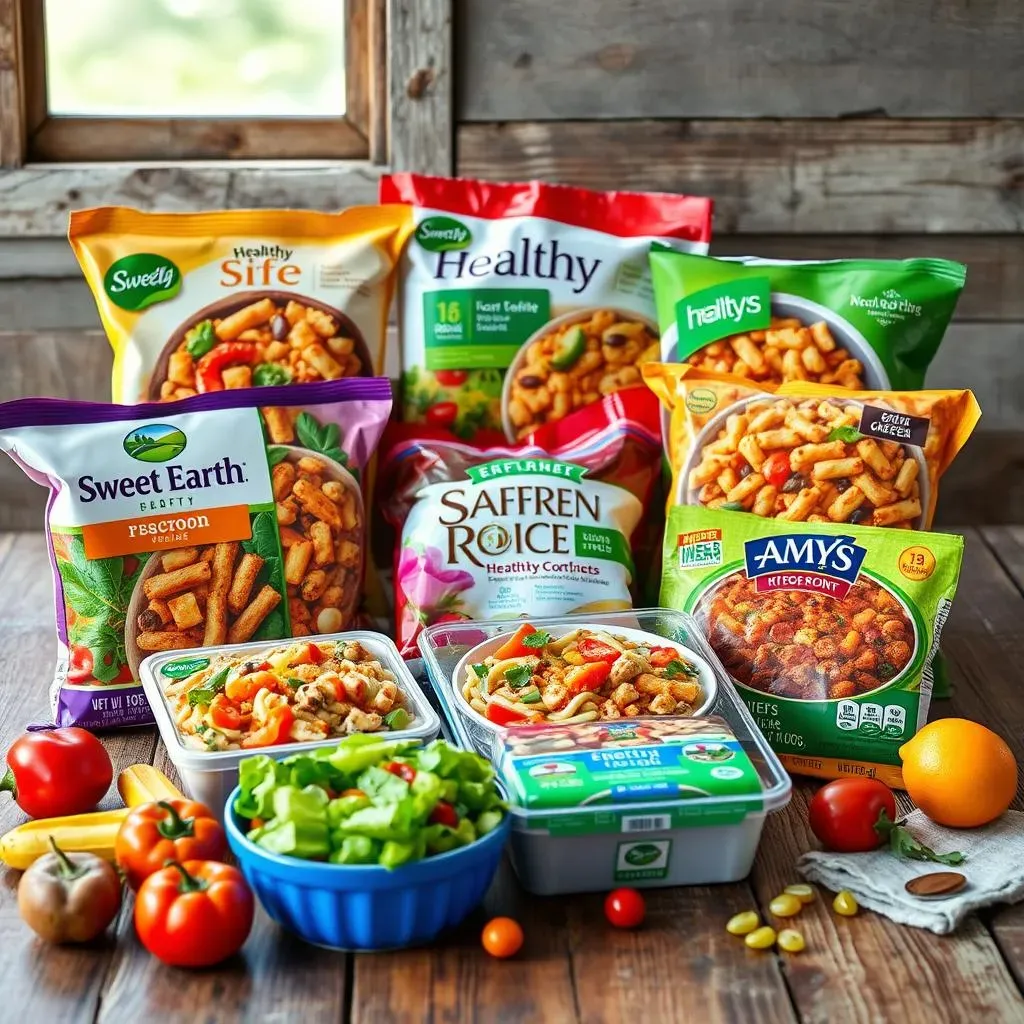Table of Contents
Ever find yourself staring blankly into the freezer aisle, wondering, "what frozen dinners are healthy?" You're not alone. Between busy schedules and the siren call of convenience, frozen meals often seem like the only option. But are they all created equal? Absolutely not! Some are nutritional nightmares packed with sodium and questionable ingredients, while others can be surprisingly good for you, even nutritionist-approved. This article is your guide to navigating the frosty landscape of frozen food. We'll break down what to look for when choosing healthy options, spotlight 16 brands that actually prioritize your well-being, and even touch on why knowing your way around a kitchen can be a game-changer. Get ready to ditch the guilt and discover that healthy frozen dinners are totally within reach.
Are Frozen Meals Healthy?

Are Frozen Meals Healthy?
let's tackle the big question: are frozen meals *actually* healthy? The short answer is, it's complicated. It's not like all frozen dinners are evil, but you can't just grab anything and expect to be a picture of health. The truth is, some frozen meals are packed with so much sodium, bad fats, and sugar that they're basically a nutritional black hole. On the other hand, some brands are stepping up their game, using real ingredients and focusing on balanced nutrition. So, while the freezer aisle isn't exactly a health food store, it's not a total wasteland either. It's all about knowing what to look for, which is what we're about to get into. Think of it like this: the frozen food section is a jungle, and we're here to give you the map and compass to navigate it.
How To Choose Healthy Frozen Meals

How To Choose Healthy Frozen Meals
Decoding the Label
so you're standing in front of that freezer, feeling overwhelmed? I get it. The first step is to become a label-reading ninja. Don't just glance at the pretty pictures on the box. Flip that thing over and get down to business. Look for the nutrition facts panel and pay close attention to a few key things. First, sodium – this is a big one. Many frozen meals are loaded with salt to preserve them and add flavor, but that's not doing your blood pressure any favors. Aim for meals with less than 600mg of sodium per serving. Next, check out the saturated fat content. You want to keep this as low as possible, as too much can cause heart problems. And finally, don't forget about sugar. Added sugars can sneak into unexpected places, so keep an eye out for that.
Then, you should check the ingredients list. This is where you find out what the food is actually made of. The shorter the list, the better. Look for whole foods – things like vegetables, lean proteins (chicken, fish, beans), and whole grains. If you see a bunch of ingredients you can't pronounce, that's a red flag. Also, watch out for artificial additives, like flavors, colors, and preservatives. These aren't necessarily bad for everyone, but they're not what you want in a truly healthy meal. The goal here is to choose meals that are as close to "real food" as possible, just in a convenient package.
What to Look For | What to Avoid |
|---|---|
Low Sodium (under 600mg) | High Sodium (over 800mg) |
Low Saturated Fat | High Saturated Fat |
Low Added Sugar | High Added Sugar |
Whole Foods (veggies, lean protein, whole grains) | Artificial Additives and Unpronounceable Ingredients |
The Power of Protein and Fiber
Beyond the usual suspects, let's talk about protein and fiber. These two are like the dynamic duo of healthy eating. Protein keeps you full and helps build muscle, which is especially important if you're trying to be active. Look for meals that pack at least 15-20 grams of protein per serving. Fiber is another champion. It helps with digestion, keeps you feeling satisfied, and can even help lower cholesterol. Meals with more than 5 grams of fiber are a solid choice. These aren't always easy to find in the frozen aisle, but it's worth making the effort. A good strategy is to combine a high protein meal with a side of vegetables or a small salad to boost the fiber content.
Also, think about organic and non-GMO. If you can find meals that are made with organic ingredients, that's a bonus. This means the food is grown without the use of synthetic pesticides and fertilizers. Non-GMO means the ingredients haven't been genetically modified. It's a personal choice, but it's something to consider if it's important to you. Don't stress too much if you can't find everything on your list. Just do your best to make the healthiest choices possible. Remember, it's about progress, not perfection. And hey, even a slightly healthier frozen meal is better than a pizza with extra cheese, right?
The 16 Healthiest Frozen Meal Brands

The 16 Healthiest Frozen Meal Brands
The Heavy Hitters
Alright, let's get to the good stuff – the brands that are actually trying to make healthy frozen meals. First up, we've got some heavy hitters. Sweet Earth is a great option if you're looking for plant-based meals with a global twist. Their bowls and burritos are packed with flavor and good-for-you ingredients. Then there's Saffron Road, they are killing the game with their globally-inspired meals that use ethically sourced ingredients. Think delicious curries and flavorful stir-fries, without the guilt. Healthy Choice is another solid contender, especially their Simply Steamers line, which focuses on whole foods and clean ingredients. And of course, we can't forget about Amy's Kitchen, a long-time favorite for organic and vegetarian options, from soups to pizzas, they've got something for everyone.
These brands are all about real ingredients and minimal processing. They're not perfect, but they're definitely a step up from the usual frozen fare. They tend to prioritize non-GMO ingredients, offer gluten-free options, and strive for a good balance of protein, fiber, and healthy fats. You'll find that they often use whole grains, lots of vegetables, and lean proteins, rather than relying on excess salt, sugar, and unhealthy fats. So, if you're new to the healthy frozen meal game, these four are a great place to start. They are like the Avengers of the freezer aisle: ready to save you from a nutritional disaster.
More Great Choices
But the list doesn't stop there. There are a bunch of other brands that deserve a shout-out. Thrive Market is a great place to find healthy options, especially if you're looking for plant-based meals. Lean Cuisine has stepped up its game with some healthier options, too, so it's worth checking out their latest offerings. Tattooed Chef is another great option, with a focus on plant-based meals, bold flavors, and exciting combinations. And if you're into a more primal diet, Primal Kitchen offers some paleo-friendly frozen meals that are packed with protein and healthy fats. These brands are really pushing the boundaries of what frozen meals can be, and it's awesome to see the progress they're making.
And let's not forget some other great brands, like Trader Joe's, which has some hidden gems in their frozen section, often at a great price. Red's All Natural is another one to keep an eye out for, with a commitment to simple, clean ingredients. Deep Indian Kitchen offers some amazing Indian-inspired meals, made with authentic spices and flavors. Cappello's is a great option if you're looking for gluten-free options, especially their grain-free pasta dishes. Planet Based Foods focuses on plant-based options with a commitment to sustainability. And finally, Milton's Craft Bakers offers some delicious pizza and flatbread options, made with simple, wholesome ingredients. So, you have a lot of options to choose from, and these are just some of the brands that I recommend. It's like having a whole team of culinary experts working for you, right in your freezer.
Brand | Focus | Why I Like It |
|---|---|---|
Sweet Earth | Plant-Based, Global Flavors | Delicious and innovative options. |
Saffron Road | Ethically Sourced, Global Cuisine | Authentic flavors and high-quality ingredients. |
Healthy Choice | Simple, Whole Foods | Clean ingredients and great for everyday meals. |
Amy's Kitchen | Organic, Vegetarian | Reliable and delicious vegetarian options. |
Thrive Market | Plant-Based, Health-Focused | Great for finding healthy and unique meals. |
Lean Cuisine | Healthier Versions of Classics | Improved options and good for portion control. |
Tattooed Chef | Plant-Based, Bold Flavors | Innovative and flavorful vegetarian meals. |
Primal Kitchen | Paleo-Friendly | High-protein and healthy fat options. |
Trader Joe's | Affordable, Unique | Great for budget-friendly and unique finds. |
Red's All Natural | Simple, Clean Ingredients | Commitment to high-quality and natural ingredients. |
Deep Indian Kitchen | Authentic Indian Flavors | Delicious and flavorful Indian meals. |
Cappello's | Gluten-Free, Grain-Free | Great for gluten-free and grain-free choices. |
Planet Based Foods | Plant-Based, Sustainable | Environmentally conscious and delicious options. |
Milton's Craft Bakers | Wholesome, Simple Ingredients | Delicious pizza and flatbread options. |
Learn To Cook Healthy Meals

Learn To Cook Healthy Meals
Why Bother Cooking?
so we've talked a lot about healthy frozen meals, and they're great for convenience, but let's be real: nothing beats a home-cooked meal. I know, I know, you're probably thinking, "I don't have time!" or "I'm not a chef!" But cooking healthy meals doesn't have to be a complicated, time-consuming ordeal. It's more about understanding the basics and getting comfortable in the kitchen. When you cook for yourself, you have complete control over what goes into your food. No hidden sugars, no excessive sodium, and no mystery ingredients. You can choose the freshest, most nutritious ingredients and tailor the flavors to your own liking. Plus, it's a skill that will benefit you for the rest of your life. Trust me, once you get the hang of it, you'll wonder why you didn't start sooner.
Think of cooking as a superpower. It's like having a cheat code to health and happiness. You can whip up delicious and nutritious meals that support your body and your goals. And the best part? It doesn't have to be fancy. You can start with simple recipes and gradually work your way up to more complex dishes. The key is to be patient with yourself, have fun with it, and don't be afraid to experiment. The kitchen is your playground, and the possibilities are endless. So, ditch the takeout menus, put on your apron, and let's get cooking!
Getting Started
So, where do you start? First, let's talk about basic kitchen equipment. You don't need a fancy chef's knife or a $500 blender. A good cutting board, a sharp knife, a few pots and pans, and some mixing bowls are all you really need to get started. Next, let’s tackle some easy recipes. Start with simple things like salads, stir-fries, or roasted vegetables. These are all great ways to learn the basics of cooking without feeling overwhelmed. Then, stock your pantry with healthy staples. Things like whole grains (rice, quinoa, oats), beans, lentils, nuts, seeds, and olive oil are great to have on hand. And don't forget about fresh produce. Visit your local farmers market or grocery store and pick up some colorful fruits and vegetables. It’s all about building a foundation.
Don't be afraid to ask for help. There are tons of resources available to help you on your cooking journey. Check out online cooking blogs, YouTube channels, or even ask a friend or family member who's a good cook for some tips. And most importantly, don't give up. You're not going to become a master chef overnight. There will be some kitchen mishaps along the way, and that's okay. Just learn from your mistakes and keep trying. Cooking is a skill that takes time and practice to develop, but the rewards are definitely worth the effort. Remember, every great cook started somewhere, and you can too.
Basic Equipment | Healthy Staples | Easy Recipes |
|---|---|---|
Cutting Board | Whole Grains (rice, quinoa) | Salads |
Sharp Knife | Beans and Lentils | Stir-fries |
Pots and Pans | Nuts and Seeds | Roasted Vegetables |
Mixing Bowls | Olive Oil | Simple Soups |
Measuring Cups and Spoons | Fresh Fruits and Vegetables | Omelets |
Wrapping Up Your Frozen Food Journey
So, what frozen dinners are healthy? It's not about avoiding the freezer aisle entirely, it's about making informed choices. You've seen that brands like Sweet Earth, Saffron Road, and Healthy Choice are making strides in offering nutritious and tasty frozen meals. Keep an eye on those labels, prioritize whole foods, and don't be afraid to experiment with different options. And while the convenience of frozen meals is undeniable, remember that learning to cook can also empower you to create your own healthy dishes. Armed with this knowledge, you can confidently navigate the frozen food section and make choices that support your health and well-being. Happy (and healthy) eating!